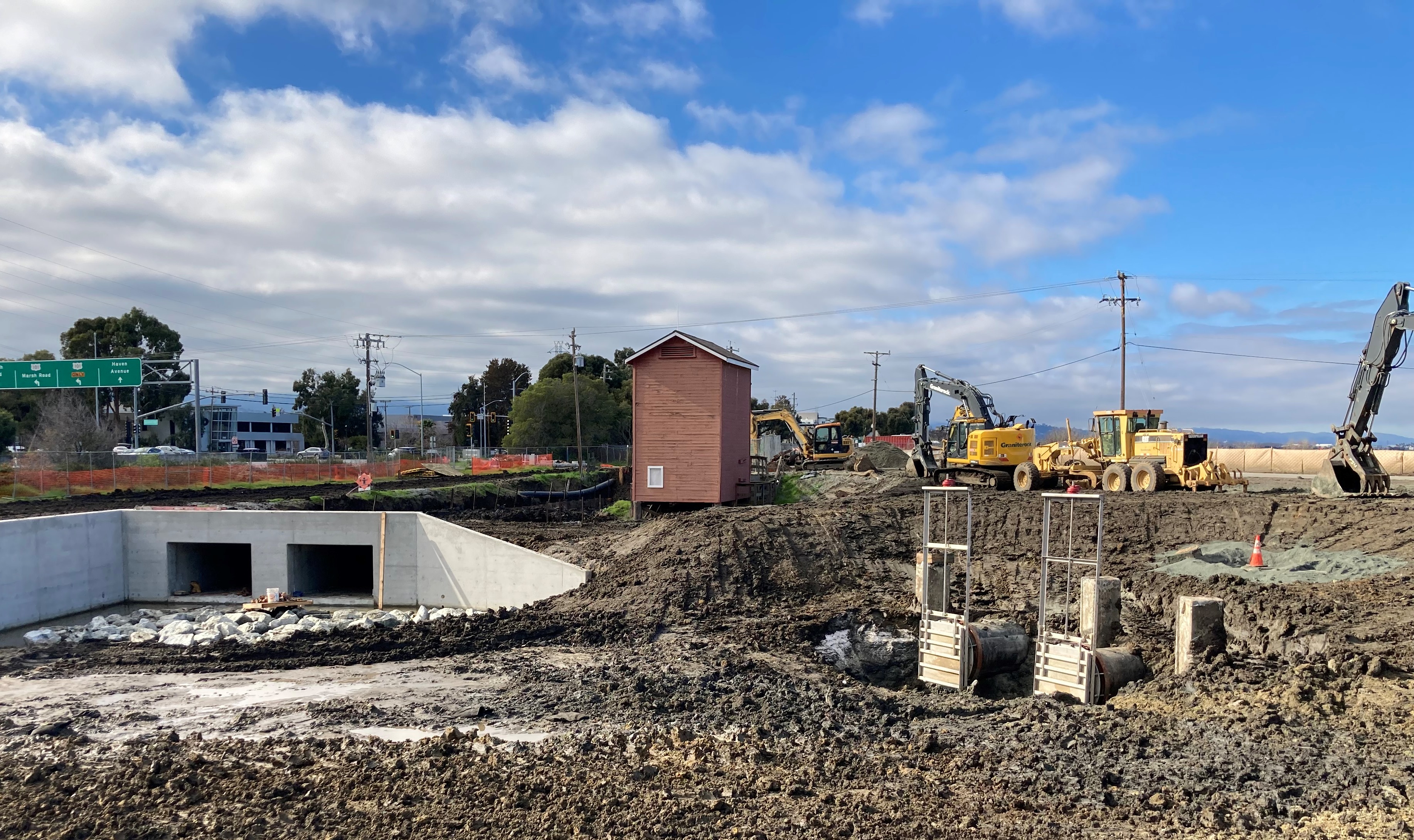Collaboration Is the Key
If you’ve been out to the City of Menlo Park’s Bedwell Bayfront Park recently, you have probably noticed that there is quite a bit going on there. I wrote about some of our work at that site recently, and I touched on the OneShoreline* organization’s Bayfront Canal and Atherton Channel Project**, more details of which are available at this link.
I thought I’d use this blog post as a way of highlighting these two construction projects underway in that same general area to highlight how important partnerships and collaboration and flexibility are – from many parties.
Fans of the South Bay Salt Pond Restoration Project know that one of the three main goals of our project is to maintain or improve the current levels of flood management. That is, we absolutely must not do anything to increase flood risk or severity, and wherever possible, we try to reduce flood risk. However, since neither of the two landowners (U.S. Fish & Wildlife Service and California Department of Fish and Wildlife) or the main funder (the State Coastal Conservancy) are primarily flood management/protection agencies, when we do make improvements to flood risk, we almost always do so by working with a local or regional flood management or public works agency.
The Bayfront Canal & Atherton Channel Project (BCACP for short…) is a great example of that process. The simplified story goes like this: Atherton Channel collects runoff mainly from Atherton, sending it downhill toward the Bay; the Bayfront Canal borders the shoreline in Redwood City & part of Menlo Park. They meet near the entry road into Bedwell Bayfront Park, typically directing stormwater into a small tidal channel named Flood Slough and then out into the Bay. However, when a storm is large enough and the tide is high enough, there is nowhere for those stormwater flows to go, and they can back up and flood nearby neighborhoods and businesses.
So, some years back, the cities of Redwood City and Menlo Park, Town of Atherton, and San Mateo County (the BCACP funding partners) worked together to design and fund a project to temporarily divert some of those peak stormwater outflows into a few of the ponds at the Don Edwards San Francisco Bay National Wildlife Refuge (Ponds R5, S5, and the S5 Forebay). Once the work is complete, the ponds will hold the water until the tide goes out, after which, the ponds can drain out into Flood Slough and then return to normal operation.
All of these waters will flow through culverts that have been placed under the entry road into Bedwell Bayfront Park. The photo above shows the large box culverts (on the left) that the BCACP installed to direct peak flows into the ponds and (on the right) the pipe culverts we installed that will empty the flows into Flood Slough.
We expect stormwater will only flow into these ponds during large storms that happen on average once every year or two. The rest of the time, this small pond group will function as enhanced managed ponds for waterfowl and shorebirds, with our large pipe culverts circulating water in and out of the ponds. In this way, our project goal of improving flood risk conditions by working with outside agencies could be met without substantially impacting our habitat goals.
Our project team was supportive and encouraging of this idea and worked with these agencies to advance it. In fact, originally, we’d included this use of these ponds as one of the alternatives in our Phase 2 environmental impact report.
OneShoreline took up the mantle of leadership on that project in 2020 and saw it through to the last stages of permitting and design. Construction began in the second half of 2021. We began construction nearby right around the same time and with the same contractor. They are both wrapping up in the coming month or two. There have been some minor logistical challenges and inconvenience, but no accidents or major problems with public access, utilities, or park closures.
We would not be accomplishing these two complicated construction projects in such a relatively smooth manner if it weren’t for the active collaboration and flexibility of many other partners:
- City of Menlo Park officials granted us an easement and have benefitted us by their flexibility and assistance with one-way traffic and other disruptions at the City’s Bedwell Bayfront Park to allow the work to proceed apace.
- We also needed flexibility from the West Bay Sanitary District and Caltrans to allow us to work around their existing infrastructure.
- Cargill also granted a property easement.
- Both projects’ funders and administrators – including the California Department of Water Resources, the San Francisco Estuary Partnership, and the BCACP Project funding partners – have shown exceptional understanding of the added time needed to build these projects because of COVID-19 and other constraints.
And of course, both sets of project proponents, contractors, and consultants had to show a lot of tenacity and follow-through to make this all happen. That includes OneShoreline, Menlo Park, Redwood City, Town of Atherton, San Mateo County Public Works, the U.S. Fish and Wildlife Service, the State Coastal Conservancy, Ducks Unlimited, CPM Associates, Graniterock, AECOM, BKF Engineering, Horizon Water & Environment, Sequoia, BioMaAS, and several other subcontractors.
We’re not yet completely done with construction, and I don’t like counting chickens before they are hatched. But I’m okay with counting eggs.
So, I’m just going to point out that we have a basket full of really good eggs that helps make all of this happen. Big thanks to all of you!
Footnotes:
* “OneShoreline” is the short name for the San Mateo County Flood and Sea Level Rise Resiliency District. Their main website is here.
**The full name of that project is even longer. It’s the “Bayfront Canal & Atherton Channel Flood Protection and Ecosystem Restoration Project.”


